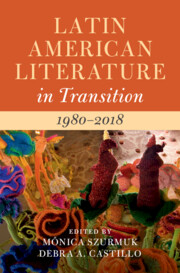Book contents
- Latin American Literature in Transition 1980–2018
- Latin American Literature in Transition
- Latin American Literature in Transition 1980–2018
- Copyright page
- Contents
- Contributors
- Acknowledgments
- Introduction
- Part I Security
- Part II New Genres
- Part III Mobilities
- Part IV Positionalities
- Part V Latin American Literature in Global Markets
- Index
- References
Part V - Latin American Literature in Global Markets
Published online by Cambridge University Press: 24 November 2022
- Latin American Literature in Transition 1980–2018
- Latin American Literature in Transition
- Latin American Literature in Transition 1980–2018
- Copyright page
- Contents
- Contributors
- Acknowledgments
- Introduction
- Part I Security
- Part II New Genres
- Part III Mobilities
- Part IV Positionalities
- Part V Latin American Literature in Global Markets
- Index
- References
Summary

- Type
- Chapter
- Information
- Latin American Literature in Transition 1980–2018 , pp. 339 - 386Publisher: Cambridge University PressPrint publication year: 2022



